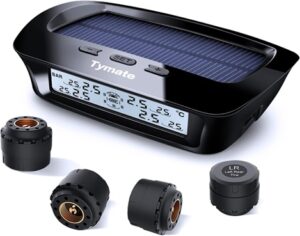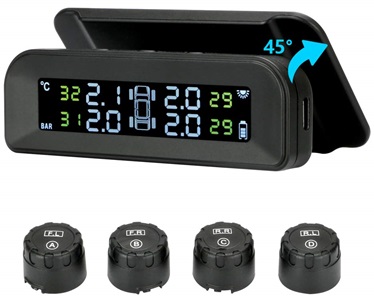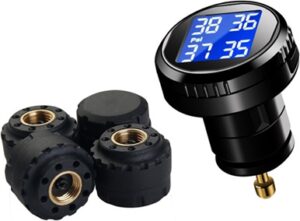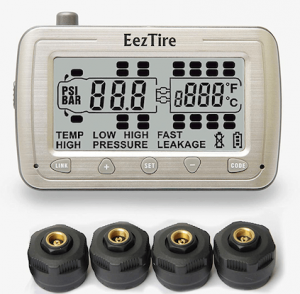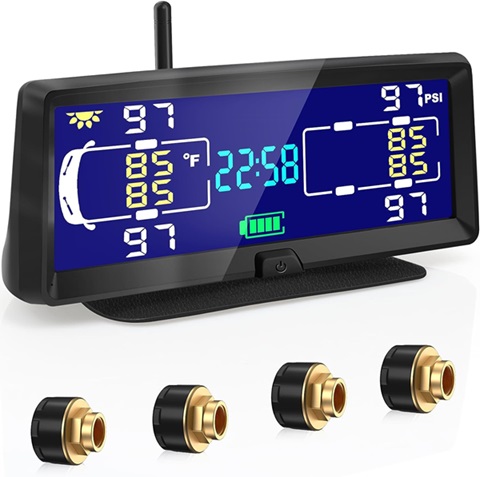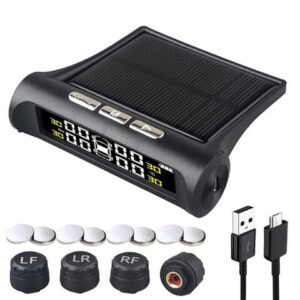Proper tire pressure is essential for both fuel efficiency and safe vehicle handling. This is where tire pressure monitoring systems (TPMS) play a crucial role. TPMS devices are designed to continuously monitor tire air pressure, alerting drivers to any deviations from recommended levels to prevent accidents, blowouts, and premature tire wear.
Key Considerations:
- Accuracy: Opt for TPMS systems that provide accurate readings within a narrow tolerance range, detecting even small pressure differences, ideally down to 1 PSI. Maximum accuracy ensures reliable performance.
- Monitoring Range: Look for TPMS models with a monitoring range of at least 0 to 100 PSI to accommodate various driving conditions and tire types effectively.
- Ease of Installation and Use: Choose systems that are easy to install and synchronize with your vehicle’s diagnostics. Clear interfaces and straightforward alerts simplify the interpretation of tire pressure readings, enabling prompt action by drivers.
To make an informed decision, we recommend going through our “Buying Guide” and checking out the list of the best products.
Best Tire Pressure Monitoring Systems – Comparison Table
Best Tire Pressure Monitoring Systems – Reviews
1. Tymate Pressure Monitoring Systems
Why it Made the Cut: Auto Solar Charge for Continuous Monitoring
The Tymate Pressure Monitoring System stands out for its advanced features, including automatic solar charging, ensuring continuous tire pressure monitoring. With top-notch solar lithium battery panels, it maintains functionality even without sunlight, providing drivers assurance on their journeys.
With five alarm types, including warnings for high/low pressure, high temperature, and low sensor battery levels, the Tymate TPMS quickly alerts drivers to any tire irregularities. Its adjustable backlight and real-time monitoring ensure clear data display in all lighting conditions. Furthermore, with energy-efficient sleep mode and robust sensors, this TPMS delivers both convenience and dependability for drivers.
Specifications
- Wireless sensors for easy installation.
- Real-time monitoring of tire pressure.
- Temp Range: -40°C to 85°C.
- Pressure Range: 0-116 PSI.
- LCD display, adjustable brightness.
- Universal compatibility with various vehicles.
Pros
- Continuous monitoring with solar charging
- Prompt alerts for abnormal tire conditions
- Clear data display in any lighting
- Long-lasting sensors with low power consumption
Cons
- Connectivity concerns
2. Jansite Tire Pressure Monitoring System 
Why it Made the Cut: Versatile windshield placement, real-time detection.
Jansite, an advanced wireless TPMS engineered with your convenience and safety as top priorities. With four external sensors, this innovative system enables real-time monitoring of tire pressure and temperature across a range of vehicles including cars, RVs, SUVs, and sedans, delivering dependable performance to keep you updated on tire conditions throughout your travels.
Featuring six distinct alarm methods, such as alerts for rapid or gradual air leakage, high pressure, and elevated temperature, ensures timely notification of any anomalies. Its digital screen showcases an LCD wide-angle display with a bright backlight, ensuring clear visibility of data readings regardless of the time of day, thereby enhancing your driving experience. Moreover, with versatile power options including solar and USB charging, you can maintain uninterrupted power for the system without monopolizing your car’s cigarette lighter socket.
Specifications
- Placement: Windshield or Center Console
- Alarm Methods: 6 types
- Charging Methods: Solar and USB
- Pressure Range: 22-87 PSI
- Transmission Frequency: 433.92 MHz
- Sensor Battery Life: 1-2 years
Pros
- Easy windshield placement.
- Real-time pressure and temperature monitoring.
- Versatile alarm methods for safety.
- Solar and USB charging options.
Cons
- Daytime screen visibility can be challenging.
3. VESAFE Pressure Monitoring System
Why it Made the Cut: Advanced sensor technology, user-friendly interface.
The VESAFE TPMS is engineered to enhance driving safety effortlessly. Utilizing cutting-edge sensor technology, it constantly monitors tire pressure and temperature in real-time, promptly alerting you to any issues. Its user-friendly interface and clear LCD display ensure easy comprehension of data with just a glance, guaranteeing convenient operation.
Installation is straightforward with the inclusion of four external sensors that easily attach to each tire’s valve stem. The system offers flexibility with both solar and USB charging options, allowing you to power it according to your preferences and driving requirements. Whether you’re driving a car, truck, SUV, or RV, this device serves as a dependable companion for worry-free journeys, offering peace of mind while on the road.
Specifications
- Sensor Type: External
- Display: LCD
- Charging Methods: Solar and USB
- Pressure Range: 0-87 PSI
- Temperature Range: -40°C to 125°C
- Alarm Methods: Visual and Audible
Pros
- Advanced sensor technology for accurate monitoring.
- User-friendly interface with intuitive controls.
- Easy installation with external sensors.
- Supports solar and USB charging for versatility.
Cons
- Limited pressure range.
4. B-Qtech Tire Pressure Monitoring System
Why it Made the Cut: Cutting-edge sensor technology, sleek design, versatile compatibility.
B-Qtech presents an innovative solution for maintaining tire conditions and ensuring road safety. Our Tire Pressure Monitoring System (TPMS) employs cutting-edge sensor technology to provide real-time monitoring of tire pressure and temperature, promptly alerting you to any deviations from standard levels. Designed to seamlessly integrate into your vehicle with its sleek and compact design, our TPMS enhances both aesthetics and functionality.
Equipped with four external sensors compatible with a range of vehicle types including cars, trucks, SUVs, and RVs, installation is effortless, requiring minimal effort and no specialized tools. The user-friendly interface features a vibrant LCD display, offering clear and concise information at a glance, keeping you well-informed and in control throughout your journey. Rely on our advanced features and dependable performance to accompany you safely and worry-free, whether you’re commuting to work or embarking on a cross-country adventure.
Specifications
- Sensor Type: External
- Display: LCD
- Pressure Range: 0-100 PSI
- Temperature Range: -40°C to 125°C
- Alarm Methods: Visual and Audible
- Compatibility: Cars, trucks, SUVs, RVs
Pros
- Cutting-edge sensor technology for precise monitoring.
- Sleek and compact design enhances vehicle aesthetics.
- Versatile compatibility with various vehicle types.
- Easy installation with external sensors and user-friendly interface.
Cons
- May require occasional recalibration for optimal accuracy.
5. EEZ Tire Pressure Monitoring System
Why it Made the Cut: High-quality construction, user-friendly interface.
EEZ RV TPMS is designed specifically for RV enthusiasts who prioritize dependable tire monitoring. Crafted with precision and durability in mind, this system assures optimal tire performance, boosting confidence on your travels. Whether you’re navigating highways or rugged terrain, provides real-time insights and control. Its high-quality sensors provide precise pressure and temperature readings, easily accessible via a user-friendly interface for effortless monitoring.
Tailor alerts to suit your preferences, ensuring prompt notifications of any abnormalities. Installation is straightforward, requiring minimal tools and effort. The compact display unit mounts conveniently on your dashboard, offering clear and concise information. Compatible with various RV models, it’s the perfect companion for your adventures on the open road, ensuring peace of mind with every mile traveled.
Specifications
- Sensor Type: Internal/External
- Display: LCD
- Pressure Range: 0-188 PSI
- Temperature Range: -40°C to 125°C
- Alarm Methods: Visual and Audible
- Compatibility: RVs, motorhomes, trailers
Pros
- Dedicated RV functionality tailored to the needs of RV owners.
- High-quality construction for durability and reliability.
- User-friendly interface with customizable alarm thresholds.
- Versatile compatibility with various RV models and configurations.
Cons
- Display unit may be bulky for smaller RV dashboards.
6. HiehaTire Pressure Monitoring System
Why it Made the Cut: Advanced technology, budget-friendly option, easy installation.
Hieha presents an innovative solution for effortless tire maintenance, utilizing advanced technology at an affordable price point. Offering consistent performance without breaking the bank, it ensures your safety and confidence whether you’re on your daily commute or embarking on a road trip. With its state-of-the-art sensors, Hieha provides real-time monitoring of tire pressure and temperature, detecting any anomalies before they become serious issues.
Featuring a user-friendly display unit, Hieha offers clear updates on tire status along with visual and audible alerts for prompt action. Installation is simple and tool-free, with a discreet sensor design and wireless connectivity for a clutter-free setup. Its plug-and-play functionality ensures compatibility with a wide range of vehicles, from cars to SUVs and trucks, simplifying tire maintenance for all users.
Specifications
- Sensor Type: External
- Display: LCD
- Pressure Range: 0-116 PSI
- Temperature Range: -40°C to 85°C
- Alarm Methods: Visual and Audible
- Compatibility: Cars, SUVs, trucks
Pros
- Affordable option without compromising on performance.
- Easy installation with no need for professional assistance.
- Wireless connectivity for a clutter-free setup.
- Wide compatibility with various vehicle types.
Cons
- External sensors may be susceptible to damage from road debris.
7. T6 Tire Pressure Monitoring System
Why it Made the Cut: Innovative design, extensive compatibility, enhanced safety features.
T6 Monitoring System, a revolutionary solution designed to elevate your driving experience. Utilizing cutting-edge technology and prioritizing dependability, it offers unparalleled performance to enhance road safety. Whether you’re navigating city streets or challenging terrain, this innovative system ensures optimal tire health and vehicle stability. Its compact design incorporates high-precision sensors for real-time tire pressure and temperature monitoring.
The user-friendly display unit provides clear data and customizable alerts to keep you informed. With advanced safety features like leak detection and rapid deflation warnings, it enables proactive measures to prevent tire-related incidents. Installation is simple, and its wireless connectivity seamlessly integrates into your vehicle’s dashboard. Built to withstand daily use, the T6 Monitoring System ensures reliable performance for years to come.
Specifications
- Sensor Type: Internal/External (optional)
- Display: TFT LCD
- Pressure Range: 0-150 PSI
- Temperature Range: -40°C to 125°C
- Alarm Methods: Visual, Audible, and Mobile App Notifications
- Compatibility: Cars, Trucks, SUVs, RVs
Pros
- Innovative design with advanced safety features.
- Extensive compatibility with various vehicle types.
- Easy installation with optional internal or external sensors.
- Comprehensive monitoring capabilities for enhanced peace of mind.
Cons:
- Internal sensors may require professional installation.
Key Features to Consider
When selecting a tire pressure monitoring system (TPMS) for your car, it’s crucial to assess specific characteristics to ensure its effectiveness and suitability. These attributes are vital for the TPMS to operate smoothly and efficiently, thereby improving your vehicle’s safety and performance on the road.
1. Wireless vs. Wired Systems
Considering whether you favor a wireless or wired arrangement is crucial. Wireless TPMS typically boasts easier installation and greater adaptability, as it eliminates the need for routing cables in your vehicle. However, wired setups could provide a more dependable and steady connection, particularly in larger vehicles where wireless signals may encounter interference.
2. Sensor Types: Internal vs. External
TPMS sensors are categorized into two main types: internal and external. Internal sensors are installed within the tire, often replacing the valve stem, providing a sleek and integrated look. On the other hand, external sensors are attached to the valve stem from the outside, facilitating easier battery replacement or maintenance.
3. Compatibility with Vehicles
Many TPMS models are designed to be compatible with various vehicle types such as cars, trucks, SUVs, and RVs, some may be better suited for specific types or models. Verifying compatibility ensures that the TPMS integrates seamlessly with your vehicle’s systems, optimizing its performance.
4. Real-Time Monitoring Capabilities
It is crucial to continuously monitor tire pressure using TPMS (Tire Pressure Monitoring Systems) to promptly address any issues while driving. It’s essential to select a TPMS that provides precise and timely pressure readings and allows you to configure alerts for both low and high pressure situations.
5. Temperature and Pressure Range
It’s crucial to think about how various driving conditions and climates impact tire pressure and temperature. Therefore, choosing a TPMS (Tire Pressure Monitoring System) with a broad temperature and pressure range is essential. Such a TPMS can handle extreme temperatures, ensuring its reliability in any weather.
6. Display Options: LCD vs. LED
TPMS units typically come with LCD or LED screens. LCD screens provide extensive information and customization options, catering well to drivers who appreciate advanced functionalities. On the other hand, LED screens offer simplicity and quick visibility, ideal for individuals seeking straightforward and convenient solutions.
Benefits of Purchasing a Tire Pressure Monitoring System
- Enhanced Safety: The use of TPMS will detect tire-related issues early and thereby helps you to reduce the risk of accidents or blowout.
- Optimal Fuel Efficiency: With the maintenance of proper tire pressure, this system will make the vehicle resulting in better gas mileage.
- Prolonged Tire Life: The system extends the lifespan of the tires by maintaining optimal pressure.
- Eco-Friendly: With its low fuel consumption, energy efficiency, and other features, this TPMS reduces carbon emissions.
- Low Maintenance Costs: Regular monitoring and real-time alerts will prevent expensive repairs and replacements.
- Universal Compatibility: The systems are designed to be compatible or suitable to use for a variety of vehicles, enhancing their versatility.
- Easy Installation: Enjoy hassle-free easy setup of the system to grab the instant benefits.
- User-Friendly Design: Its intuitive interfaces will allow for effortless monitoring.
- Peace of Mind: This TMPS will allow the user to drive confidently, as it lets you know the tires are in top condition.
- Compliance: Since it meets various safety regulations in some regions, these TMPS will prevent you from paying fines.
How Do Tire Pressure Monitoring Systems Work?
Basically, TPMS systems are of two types (not based on models, but on their functionality). They are Direct TPMS and Indirect TPMS frameworks. Let’s see how each of these two work.
1. Direct TPMS
A direct TPMS has a sensor that is placed on top of the wheel’s gauge inlet. This will measure the air pressure of each of the tire and constantly monitors it. Whenever the system detects the drop of pressure below 25% or below the recommended levels, the sensor gets triggered, activates and sends an information signal in your car’s computer system. This will also trigger your TPMS dashboard’s indicator light to alert you that the tire’s air pressure is low.
2. Indirect TPMS
Indirect TPMS systems work in line with your car’s ABS or the Anti-lock Breaking system sensors. These speed sensors are present on the wheels and simultaneously can sense the tire’s low pressure as well. This is because when one of the tire’s pressure is low, it would spin differently than that of the other tires. This information would be sensed by the device and sent back to the computer system in your car. This would then trigger the dashboard’s indicator light and thus inform you.
Tire Monitoring Pressure Systems – FAQs
Ans: No, TPMS became mandatory for all new vehicles sold in the US after 2007, but older models may not have this feature unless retrofitted with aftermarket TPMS kits.
Ans: It’s recommended to check tire pressure at least once a month or before long trips, as changes in temperature and driving conditions can affect tire pressure.
Ans: Yes, TPMS sensors can detect slow leaks by monitoring pressure fluctuations over time and alerting drivers to potential issues before they become critical.
Ans: Yes, TPMS sensors can be programmed to alert drivers when tire pressure falls below or exceeds specific thresholds set by the manufacturer or user.
Ans: Yes, TPMS sensors are compatible with run-flat tires and can provide real-time pressure monitoring to help drivers make informed decisions during emergencies.
Conclusion
When selecting a tire pressure monitoring system (TPMS), weigh factors such as wireless connectivity, sensor variations, compatibility, real-time monitoring, temperature, pressure range, and display choices. Prioritize these aspects according to your requirements to enhance safety and effectiveness. A reliable TPMS promptly handles pressure concerns, ensuring tire upkeep and providing assurance. Make a discerning choice for secure and confident driving. Below are some suggested options.
- Tymate Pressure Monitoring Systems employs wireless sensors for real-time monitoring, functioning effectively across various temperature and pressure conditions and compatible with the majority of vehicles. It boasts easy installation and a customizable LCD display, ensuring convenient and precise maintenance of optimal tire pressure.
- The VESAFE Pressure Monitoring System distinguishes itself with user-friendly design and accurate monitoring capabilities. Its wireless sensors facilitate easy installation, while real-time pressure monitoring ensures swift notifications. It functions effectively in diverse temperatures and is compatible with a wide range of vehicles.
- The T6 Tire Pressure Monitoring System is renowned for its impressive features and reliable operation. Its wireless sensors facilitate effortless setup, while continuous monitoring ensures prompt alerts. With versatile temperature and pressure settings, it excels in varied driving conditions.

